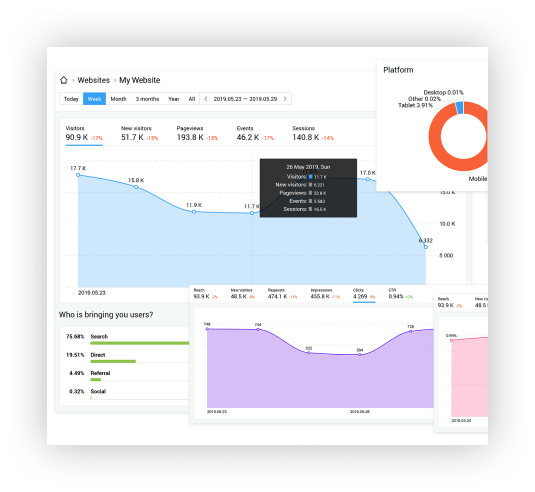Blog
Analytics in Sports Marketing

Analytics in Sports Marketing
Sports has been a big business for quite some time now. Analysis of data and information can help you be updated with the latest marketing techniques and fruitfully utilize the sports operation. Now, you might wonder how one can use analytics in identifying the latest sports trends. The three fundamental questions in sports marketing analytics which every individual finds amusing are:
- Why is analytics used in sports marketing?
- What are the data that are collected for analyses?
- How is the data collected?

Role of Big Data in Sports Marketing:

Analyzing big data in sports marketing has changed the marketing strategies, making it more efficient and approachable. To analyze the data, a sports marketer must first get an inclusive idea about big data and what role it plays in the specific field. By understanding the overall concept of big data, an organization gets a competitive advantage over itself.
What is Big Data?

Big Data has generally been termed a wide variety of information assets that enable inclusive insight, decision-making processes, and process automation. For instance, let's assume a cricket event has a 60% male audience and 40% female audience. This information enables the organization to promote further their events in places where they seem to find lucrative outputs.
What is the starting point?
Big data mainly helps sports organizations keep track of their amplified and diverse range of audiences. For example, the most popular football team Juventus a few years back had mainly the audience base of male followers who were mainly Italian or European. But nowadays, the number of female followers of the team has increased to a considerable extent. Similar is the case with the nationality of the followers. This expansion of interests across the national borders takes reliable information assets to address and target this diverse range of audiences.


What is beyond Big Data?
Now one might ask, is there something beyond big data? The process of going beyond segmentation and focusing on individuals is called personalization. The sports marketing faculties can create customer-oriented operations, generate customized email campaigns to address the interests of every individual in the follower group. The process is all about collecting relevant information from each individual and having a better understanding of the audience in a micro sense.
Use of Data Analysis:
To simply put it, data analysis in sports marketing aids in the general fan profile-reading. Leveraging information regarding where, when, and how sports fans engage with sports products, merchandise, and what kind of sports campaigns attract the fans the most, you can quickly determine the most effective product offerings and marketing initiatives that will maximize the lifetime value from both hard-core and casual fans.
Marketing begins with knowing the customers and their preferences. Sports marketing is no exception; here, one needs to know the fans and what they want from particular sports or organizations. We all know sports brands don't have customers; they have enthusiastic fans. These fans are passionately engaged to the content produced by the different sports organizations all over the world. This eventually expands the domain of audience and expectations in the case of sports marketing.
Marketing faculties in sports organizations receive billions of data points every day through social media engagement, and this can increase the volume of data that eventually grows as time passes. Manually it is impossible to keep track of every database. This is the time when a particular system acts as a savior.
CRM (Customer Relationship Management) systems gather databases on the customer, including information on customer demographic, psychographic, product usage, which further involves transactions, inquiries, and interactions between the fans and the organizations. About 64.5% to 69.5% of all sports, including team, venues, and leagues and over 79.5% of significant league baseball use Dynamics CRM to be relevant and satisfy their fans.
How CRM aids in Sports Marketing?
As we now know CRM is a software which helps the sports organizations in developing and managing their relationship with the fans. Following are the ways in which CRM helps in Sports Marketing analytics:
-
To generate a detailed Fan Profile: Caroline Schrader, the senior manager for revenue strategy at Washington Nationals, has stated during a panel discussion of CRM Evolution, the team has the ability to get an inclusive insight of the fans' engagement to the team, what kind of mails the fans are opening, what kind of merchandise they are interested in. The senior manager has also stated that these databases help the team improve their marketing initiatives and engagement strategies.
-
Customized messages for Promotions: With CRM, sports organizations can easily section their fans according to their preferences. This segmentation further helps the companies in sending customized messages for email campaigns. The system also offers click-through rate formulas that show the positive impact of the campaigns and promotions.
-
To increase Ticket Sales: By having an overall view of the fans, increasing the sales becomes effortless. The fans' preference towards types of seasons, leagues, and packages makes the organizations build the right approach while selling their tickets. Fans are 35% likely to purchase a ticket plan if they find the plan is customized for them, according to Russell Scibetti, president of KORE Planning and Insights.
-
To get Sponsors' Support: Sponsors nowadays do not want to remain connected with the team; they want to expand their domain and have more intricate interactions with the fans. Sponsors demand to know the proper details of the fans and how they can match with the team's or organization's image. In order to provide the Sponsors with relevant details, CRM helps the sports teams.
Consistent Fans Engagement: Even loyal and die-hard fans get distracted, and to keep them engaged, the sports teams and organizations have to work on their marketing initiatives. The most crucial step in engaging the loyal and casual fans is to get a better insight into their preferences and customize the products according to that. CRM helps in this process.
Where does the data flow from in sports marketing?
The primary method of data collection is promotions. Both online and offline promotion events like the sweepstakes can generate a lot of details about the fans. Loyalty programs are another way of interacting and collecting data about the fans. The method of collecting information through apps that are very common in the NFL now. The apps provide information about team news, videos, clips, and advertisements for online sports product shopping.
Analysis shows that North America holds the largest market share in sports analytics, followed by Europe. Some analysts predict by examining relevant details that the global sports analytics market will grow up to US $616.7 million during the year 2021 at a rate of 37.9% Compound Annual Growth Rate (CAGR). The demands of marketers and sports organizations management will boost this growth to meet the historical as well as accurate time recognition into data-generated methods both on and off the field.
The first step in sports marketing is to chart out the area that needs to be targeted, and that is demanding improved initiatives from the organization's side. The reason behind sports marketing can include one or more of these- attracting the audience, enticing casual fans, increasing viewership, and attracting prospects. Data analysis can help the sports organizations derive a model of variables that affect the marketing strategies and elements such as social media activity and sponsorship to help the right kind of audience and achieve the goal a team is aiming for.
Where does the data flow from in sports marketing?
Till now, we have seen how analytics help in sports management and marketing measures. The process of implementing those databases and analysis into designing a marketing strategy which will ultimately result in the final output. For example, data of a particular sports team suggest that the fans are most likely to attend the games on Friday and Saturdays. This information can help the team layout specific strategies that will amplify their sales even more, like conducting family events on Sundays, giveaways for weekday events, not allowing additional promotions on Friday games, etc. The vital steps in developing a perfect sports marketing strategy are:
-
Identifying the problem.
-
Doing background research for developing a common research question.
-
Data collection.
-
Analyzing the collected data.
-
Presenting the results in such a way will help in the process of taking action.
Conclusion
The aspect of data analysis in sports marketing is to increase revenue and enhance the fan experience. However, efficient communication of databases is all that matters in sports marketing. Sports marketing analysis is vital in understanding the positive outcome of the strategies and further improved initiatives which need to be taken to keep the fans engaged. Technology and resources have progressed in making data collection effortless, resulting in organizations fighting for a competitive advantage in the sports market. Improving the marketing schemes and targeting more audiences through digital data collection only makes sense in this tech-abled world.